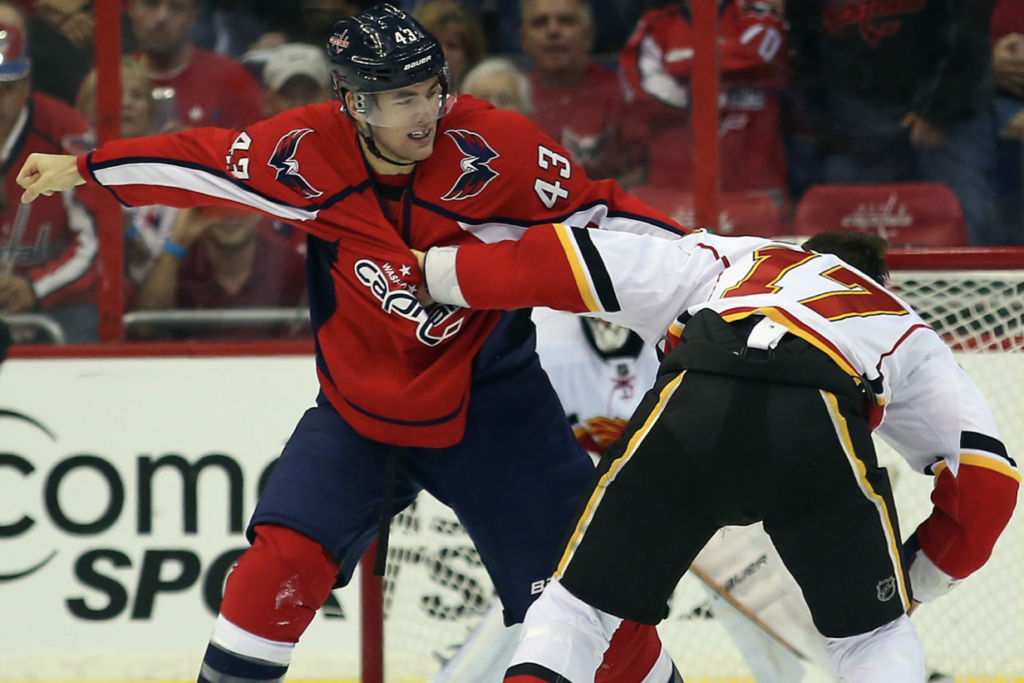The “Code”: Hockey’s Reasoning and Defense of Fighting

Image Courtesy of Bleacher Report
By Luke Weidenkopf
“I went to a boxing match and a hockey game broke!” is a classic adage pertaining to how hockey games were perceived in the latter half of the 20th century. The rise of fighting in the NHL led to elongated games, which far surpassed the normal 3 hour run time, and exploded to the point where some games took upwards of 5 hours.
In more recent news, fighting in hockey has spearheaded to one of the biggest issues in the game. With the recent news of the Quebec Major Junior Hockey League (QMJHL) banning the action, many are declaring this as the beginning of the end for fighting in the sport.
Fighting has been ingrained in hockey players since the creation of the sport, but the meaning or reason behind these violent displays has been lost in time and now many question its origin and do not understand why it continues to have a place in the game. Fans will see a fight break out, and only see the aftermath but not the prelude that caused the fight to begin. They assume that two opposing players just decided to drop gloves and hash it out. But what they fail to recognize is that there is a “Code” behind these fights. Every player belongs to it and every player follows it.
The ”Code” has been an integral part of hockey from its origination in the late 1800’s. It is an unwritten set of rules that everyone who plays the game somehow knows. It’s much like waiting in the line of a grocery store. No one really knows why it started or why we follow it, but we simply do.
This unwritten set of rules has evolved with the game of hockey but the core tenants have remained. Not everyone who plays the sport follows these rules and those who do not are not looked upon fondly. The most important point, the pinnacle pillar is that the team (and your teammates) always comes first. Bob Hartley, coach of the 2001 Stanley Cup winning Colorado Avalanche, said “a hockey team is like a puzzle. Every piece is vital.” So, if an opposing player lays a cheap hit on one of your teammates, then you drop the gloves and go to your teammates defense.
This is one of the reasons why hockey games in the late 70’s and 80’s took so long. Once a fight broke out, every player on the ice would have to choose a dancing partner to square up with. Each man would fight, and the two linesmen on the ice would have to separate the players, put them in the box, and then attribute to them the proper penalty. Fighting also grew in popularity among fans and many owners believed this to be a possibility in generating more revenue. Thirdly, with owners calling for more fights and by proxy more fighters, “goons” started to enter the league. Goons were relatively unskilled players whose one purpose in the lineup was to protect the star players and punch the other team in the face. The conscience act to make hockey more about fighting distracted fans from the actual entertainment of the game and made them focus on the blood being spilled.
The game then transitioned away from goons and all-out-fights progressively, although many argue that the definitive change occurred over the 2004-2005 lockout season, when the NHL and the NHLPA suspended the season over labor disputes. When hockey returned the following year, Gary Bettman, the NHL commissioner, instituted many new rules which targeted fighting and other violent acts in the sport. These rules transitioned the game to be more focused on skill and speed and avoid the bloodshed that had given people a false impression of the sport.
In the NHL today, fights have severely decreased. Goons have virtually disappeared from the NHL with only a handful still existing in the league (although they still do have a presence in the minor leagues: AHL, ECHL, etc.). And fighting in hockey has returned to its original purpose, defending your star players and teammates. Now when a fight breaks out it is normally because of one teammate defending another. If one team lays a dirty hit, they must expect to answer the bell from the other team.
And so, the “Code” does have a point. Its original purpose has mostly returned to the modern game. So, when you see a scrum at the net or two players dropping the gloves at center ice, remember that it is part of the “Code.” It has a purpose. The players aren’t fighting just because. It’s in the sport, ingrained in them from when they first laced up their skates. It’s who they are and not something they can change.







